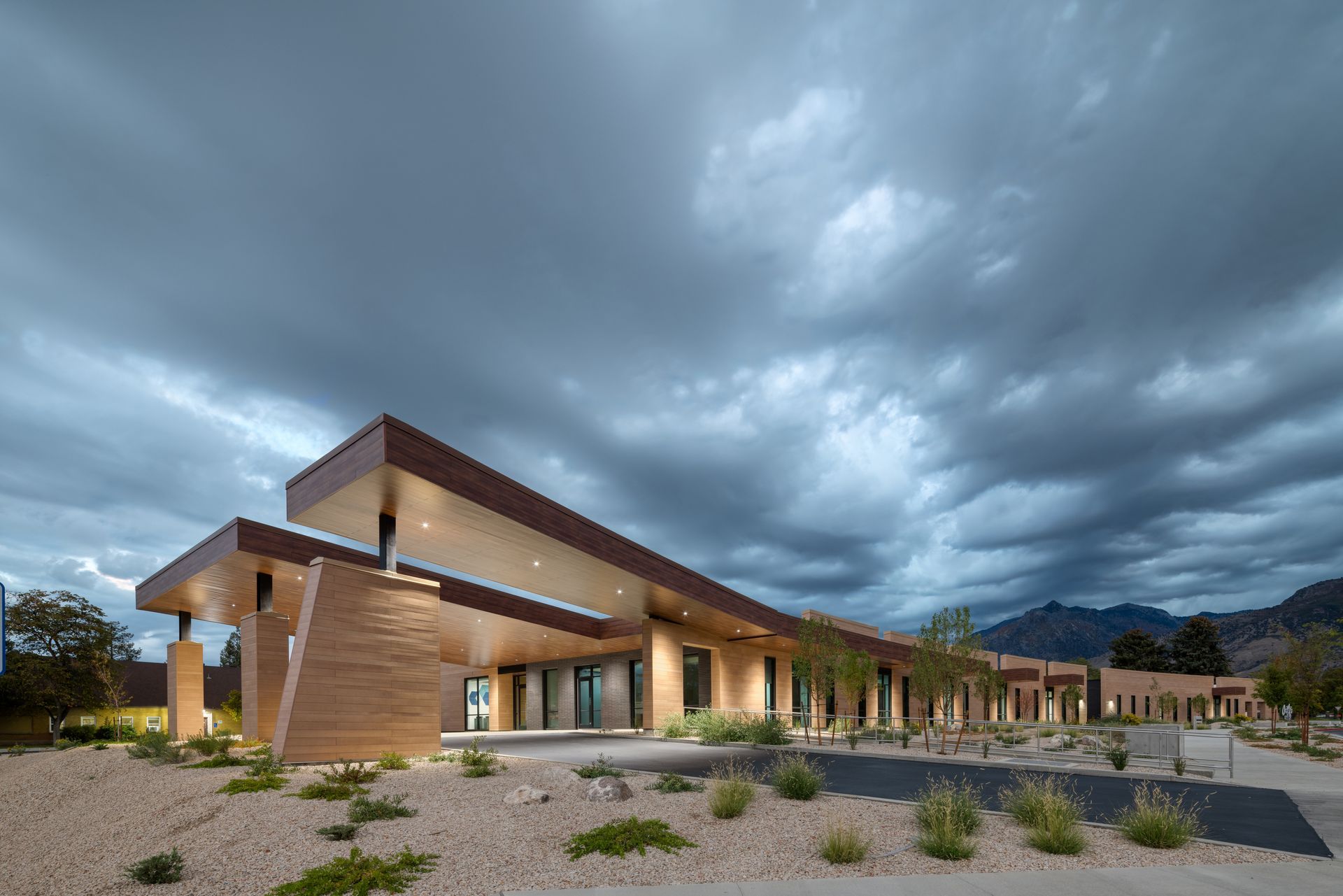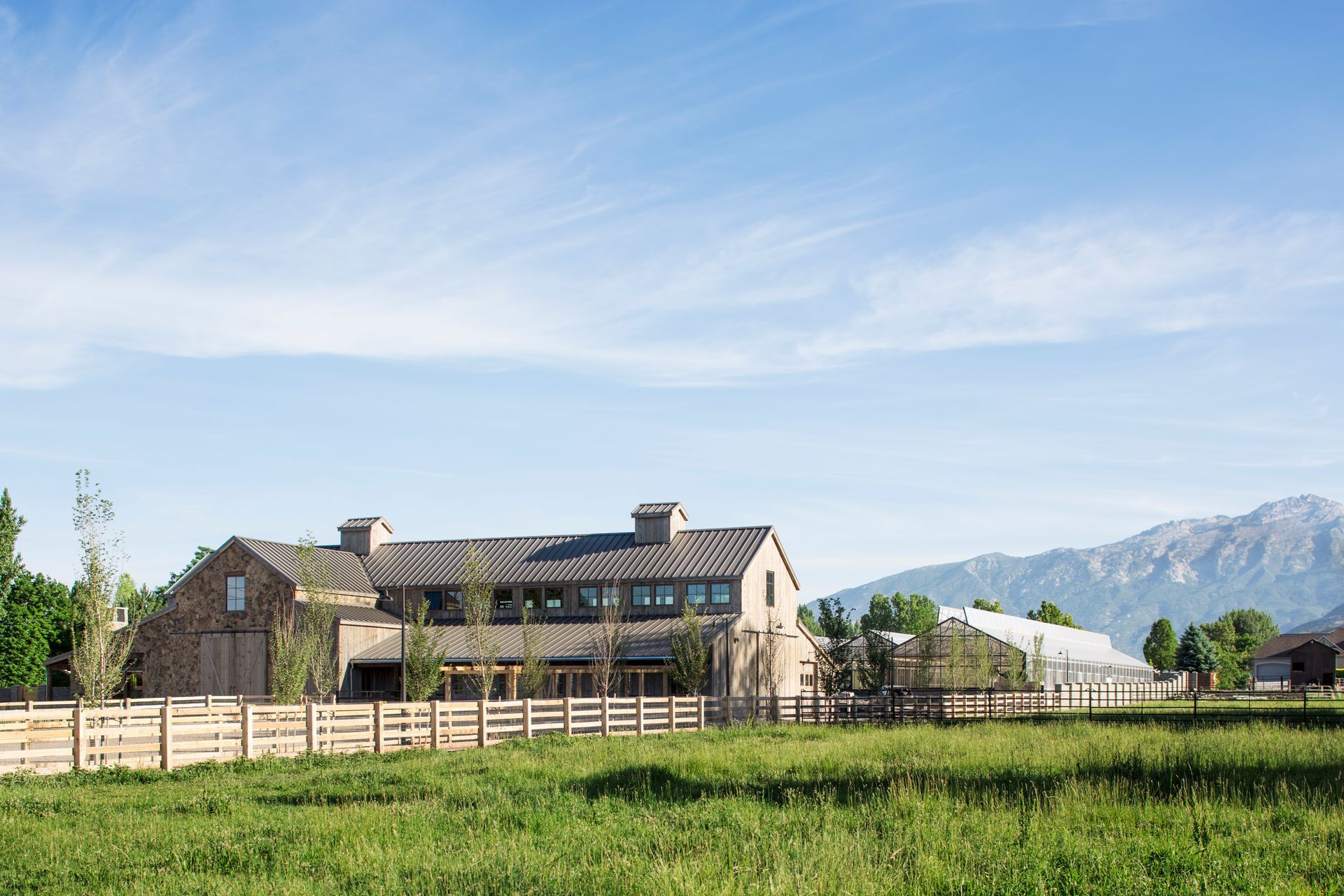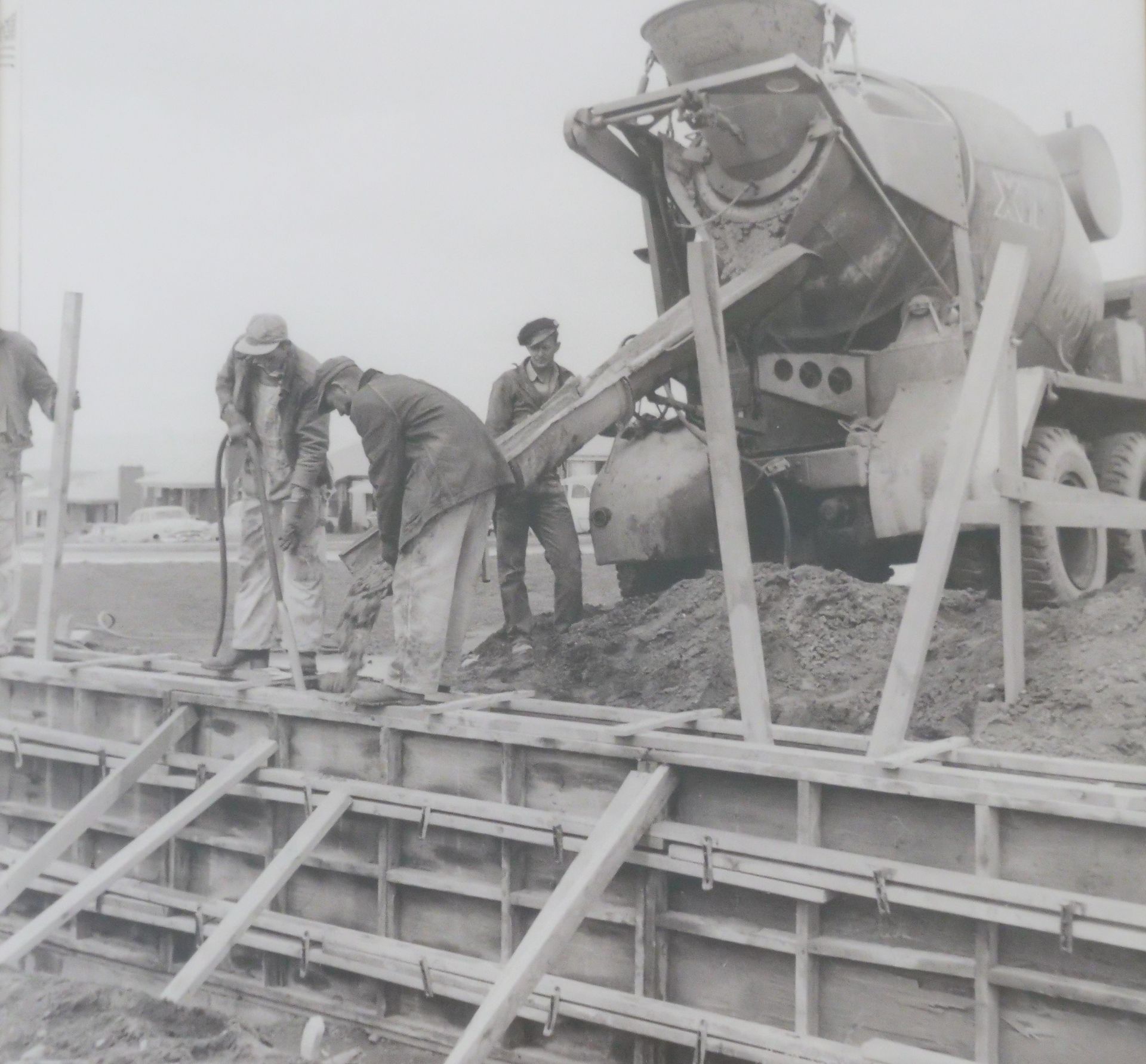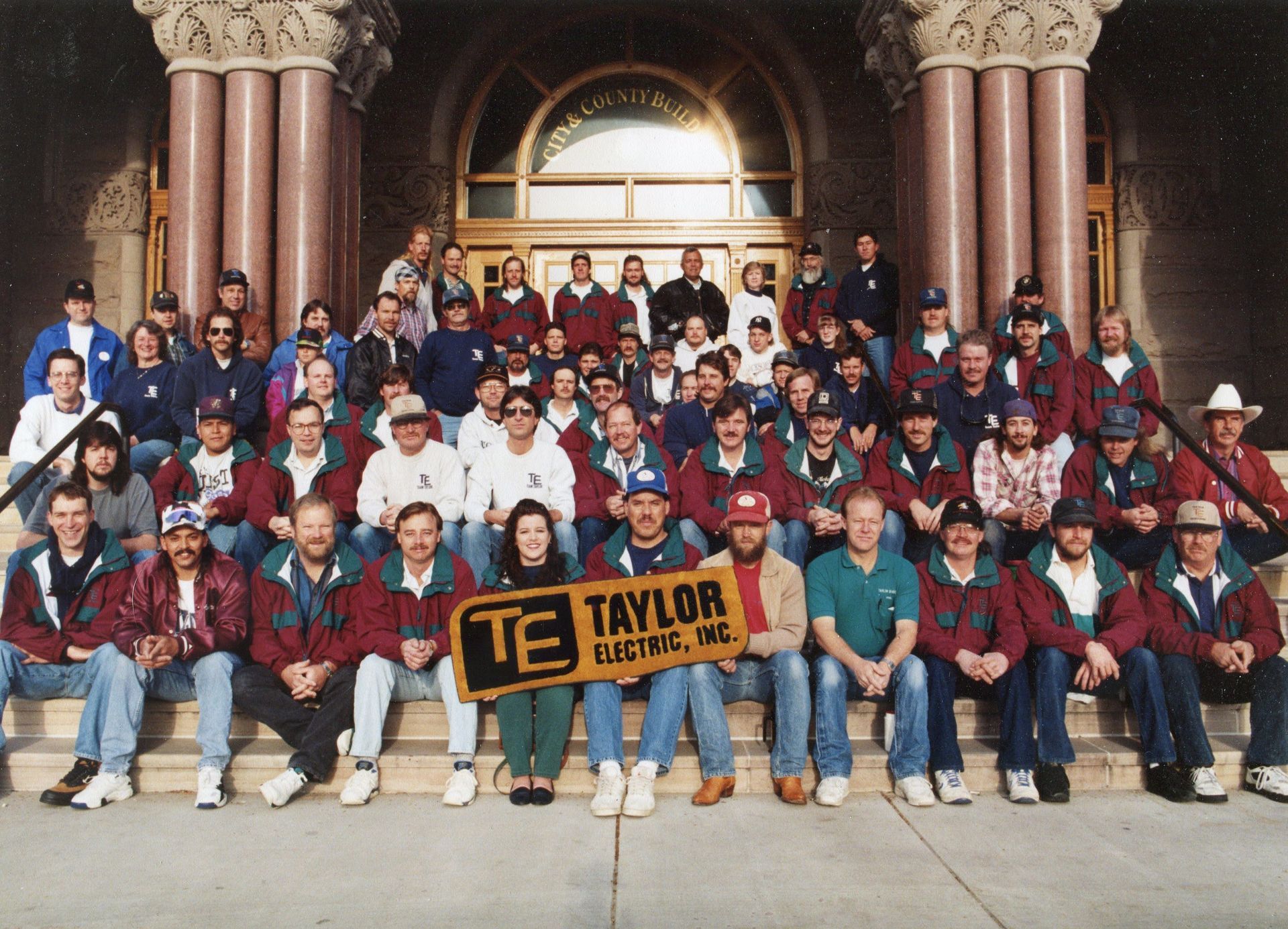Perfect Calling
The face of Utah's AGC chapter for four decades, Rich Thorn's positive impact on Utah's construction industry has been nothing short of legendary.
Capitalizing on his family’s good name—and his own gregarious, optimistic nature and personal charm—Rich Thorn has been among the most prominent advocates of Utah’s construction industry for more than 40 years.
As the President/CEO of the Associated General Contractors (AGC) of Utah, Thorn has been the proverbial face of the association since assuming the title of its top executive in October 1982—just before reaching 25 years of age. It has proven to be a role tailor-made to his
skills, education, and upbringing.
“Every day is a great day,” Thorn exclaimed during an early February phone call to discuss how he was feeling after AGC of Utah’s 100th-anniversary convention. Besides it being the coveted century mark in time, this year's event was particularly special to Thorn due to the remarkable turnout and energy level of those who attended.
“Our numbers [of attendees] were above those of pre-Covid numbers, and couple that with the companies who were sponsors, we were really happy with the turnout,” he said.
It was also significant in that it was his second-to-last AGC convention, as Thorn, 65, recently announced his retirement, effective at the end of the state’s legislative session in March 2023.
“I’d be less than honest if I didn’t feel some bit of nostalgia,” he said. “This is the next to last one; there is a lot of sentimental value, as I’ve been through a lot of these.”
Over the past couple of years, Thorn has been gradually handing over the reins of the chapter to long-time AGC of Utah Vice President Joey Gilbert, with Melissa Camp, Director of Finance and Administration, also filling a vital staff role. Gilbert and Camp were hired in 1997 and 2003, respectively, and have more than 40 years combined experience, yet are acutely aware it’s going to be challenging filling Thorn’s shoes.
“He’s the eternal optimist, liked by everyone,” said Gilbert, trying to sum up Thorn’s character in a few words. “He’s always upbeat and treats everyone like a best friend. I get that comment all the time.”
“I’ve been trying to convince him not to leave,” laughed Camp. “He cares—that’s the biggest thing. And cares not just professionally, but about your personal life. We’re calling this his ‘farewell tour.’ It’s hard for him 100% to step back, but he’s trying. He’s trying to take it all in and enjoy it.”
Ideal Upbringing included Construction and Politics
A native of Springville, a relatively small Utah town with a rich history of heavy/civil contractors, Thorn was born into a prominent construction family. Great-grandfather Ashel O. Thorn started Thorn Construction in the 1920s, with grandfather Paul Thorn (AGC of Utah President in 1947) and great-uncle Grant Thorn also running the firm for many years, before it closed in 1981.
His father, James (Jim) Thorn, worked at the company for many years as a laborer, heavy equipment operator, foreman, and superintendent/project manager. Fond memories from Rich’s youth include staying at motels during the summer in towns like Orderville in southern Utah and Delle in Utah’s west desert, while Jim managed paving jobs.
Thorn spent summers in high school and college working at Thorn Construction, learning how to operate loaders, dozers, and asphalt pavers—great hands-on experience of what happens in the field.
“For me, that’s always been helpful because I can relate to what that’s like,” he said. “I will never forget the guy wallowing in the mud, laying pipe, making it happen on the job site. That’s where the work gets done.”
One powerful early memory came via a job site visit with Grandpa Paul, on a day with rather inclement weather.
“It was a lousy, rainy, bad day,” Thorn recalled. “We pulled onto the job and Grandpa Paul was the executive. He was wearing brand new Florsheim shoes. He got out of the car and walked through the mud to shake the ‘Cat skinner’s hand. I will never forget that. He saw the value of the people he worked with, and that’s the term, he worked with them. The Thorn name meant a lot in the construction industry; our company had a good reputation.”
On the flip side, his mother, Karen, was perhaps even more influential on Thorn, given her vast political clout and lengthy career that included working for two U.S. Congressmen and two U.S. Senators for 35 combined years, in addition to serving on multiple community and political organizations. She was sharp, with an infectious smile and a keen ability to connect with people of all persuasions.
Karen’s career included working in Washington D.C., which uprooted the family from tiny Springville and had them living in the nation’s capital from 1961–1964, Thorn’s first three years in elementary school.
The experience was magical for young Rich, with “family field trips” most weekends to different historical U.S. sites. He’s been to D.C. dozens of times throughout his professional adult life. He cites D.C. as perhaps his favorite city.
“He’s his mother, through and through,” said Thorn’s wife of 43 years, Sherrie. “He’s got his dad’s [gift of gab] skills—he likes to talk—but he’s got his mom’s kindness. His mom was just genuine.”
Karen’s ties helped Thorn effectively navigate Utah’s political waters at an early age, and his 40 years of lobbying on Utah’s Capitol Hill has been consistent and effective, year after year. He’s been resigning from various labor and pension boards and other workforce and industry committees (upwards of 15-plus during peak years) while having Gilbert step in to fill the void.
“It’s all part of the plan,” Thorn said. “It’s flattering to be called by the Governor to serve on a board or as a chair of a committee. I feel obligated to serve and I’ll give it my best. It’s nice to have people ask for your opinion.”
Thorn remains engaged in this year’s legislative session, having been to Capitol Hill three times, and is reading legislation, giving input, and suggesting amendments while Gilbert is running point.
“I’m up there as his wingman,” said Thorn. “We talk every day. That’s part of the [transition] process. It’s been a bit of a learning curve for me to sit back.”
Family First
Thorn said the single greatest benefit of working for the AGC, for himself and Sherrie, was being able to comfortably raise their family of four children. They met at Dixie College in 1976—Thorn was on scholarship playing football and baseball—and married in June 1978.
In the fall of 1980, he got wind of a staff assistant position at AGC of Utah and was hired to work under Horace (Hod) Gunn on September 15. It proved to be a great fit, with Thorn’s construction background and jovial nature making him an instant asset to the association. When Gunn announced his retirement less than two years later, both Thorn and his wife felt he was ready to take over as AGC’s top executive. They weren’t sure the Executive Committee and Board of Directors felt the same way about a 25-year-old, but they were optimistic at his chances, nonetheless.
“We were hoping and praying he’d get it,” recalled Sherrie, “but he still had to compete with everyone else. He had an advantage because he had the [staff assistant] job for two years. He was a young buck, but he had the family name and he loved the job. He was a perfect fit.”
Thorn remembers interviewing with the search committee, including Walter Christiansen, Allen Young, John Tempest, and committee chair Ted Jacobsen. They told him, “We’re going to give a young guy a chance,” according to Thorn. “I believe the Thorn name and my mom’s political prowess neutralized the ‘He’s too young’ discussion. I knew a lot of [AGC] members on a first-name basis before I ever walked in the door. I also brought something they recognized—potential.”
He was named Executive Manager (later called Executive VP, then President/CEO in 2000) in October 1982 and poured his soul into the job. The construction industry was struggling at the time, with Utah and the US still reeling economically from the fallout after the Savings and Loan crisis.
“Life from September to January, they are so busy,” Sherrie said about convention prep. “It’s just nuts. It’s a lot of work for Rich, Melissa, Joey, and the staff. It’s crazy. That ends, and lobbying at the Capitol begins. Lobbying is not so bad now, but back in the day, Rich was (at the Capitol) morning, noon, and night.”
She credits Camp and Gilbert for their hard work and contributions to making the association better over the past two-plus decades. “Rich couldn’t have done it without them,” she said. “They are his right and left hand—they’re a team.”
Chips Off the ‘Ol Block
Thorn’s three sons—Cody, Brady, and Tyler—all ended up pursuing careers with ties to the construction industry, and speak glowingly of their father’s impact on their respective success.
“Everything I do has been by observing how my dad handles and treats people,” said Brady, Sr. Vice President at Murray-based Beehive Insurance. “As a result of that, my career has been very successful. I believe in the ‘Golden Rule’—you treat the janitor and the CEO with the same level of respect. People like it when they are appreciated and valued. I know my clients’ wives and friends, their victories and successes.”
“I was literally raised by the AGC,” said Tyler, Area Manager for Bridge Source. “I’ve attended conventions, conferences, and golf tournaments in a stroller, and now I attend those same functions with my wife, and we’ve taken our babies to conventions.”
Tyler continued, “From a son’s perspective, he has always been a selfless person. He was always available, always willing to help. You can tell that work meant a lot to him and he was good at it, but we were the top priority. He would move heaven and earth to go to anything we did—scout camps, baseball tournaments, everything. He’s available if I need to bounce an idea off him, but we always talk about other things …sports, politics. He’s well-rounded in that regard.”
“His support has been amazing with me starting a new company,” said Cody, who founded Thorn Milling & Construction in 2018. “I reached out to him many times if I was having a hard time with a particular project. He’s always told me to be calm and collected and keep your composure. People jump to conclusions way too quickly. Treat people the way you want to be treated, and surround yourself with people who will make you a better person.”
Cody added, “I’ve never seen dad lose his cool. Also, when it comes to his leadership role at AGC, people look up to him. They learn from him. When he speaks, he demands your attention. Plus, he’s a phenomenal listener.”
Thorn said he’s proud of his sons’ career accomplishments thus far, and also wanted to give a shout out to his daughter, Shelbie, and her husband, Chris Curtis. Shelbie and Chris are the proud parents of three children and reside in Salt Lake County. Shelbie said her father’s strong work ethic and ability to make friends are among his hallmarks, but “work was work, family came first.” As she got to be a teenager and hanging out with friends, her dad used to tell her “remember who you are. It’s just stuck with me. I’m a Thorn and we take pride in our name. I’m doing that now with my kids.”
A Legacy of Excellence
The AGC has long attracted the “best of the best” from Utah-based general contractors to lead the chapter, including company owners, presidents, CEOs, and other high-ranking executives that fill various executive committee and board of director positions annually.
So Thorn, needless to say, has worked with hundreds of talented, influential people over the years, spanning every type of construction—from general builders to highway and utility contractors, and everyone in between. Praise for his inclusive nature and effectiveness as the chapter’s long-time leader is found in spades.
“He’s an ‘A-game’ type of guy—and he does it with a smile on his face,” said Bob Tempest, former Vice President for Murray-based Tempest Enterprises, and a long-time advocate of AGC of Utah who served as Chair in 2011, and as a Lifetime Director for a decade.
“Rich has always demonstrated that he’s in the service of the industry,” said Tom Case, former Granite Construction executive and 2005 AGC of Utah Chair, who now operates TCM Services in Park City. “It’s through that service that he adds value to the members, and it’s why people keep coming back.”
Case, who also served as Director of the Highway/Transportation Division for AGC of America in 2014, said Thorn’s impact is recognized nationally by other chapters.
“I got to see other [AGC] chapters and how they do things, and I would say Utah is one of the best in the country, and that is a direct reflection on Rich, Joey, and the team.”
“To his fellow chapter executives, he is always willing to share what he and the Utah AGC does that is successful. At the same time, he’s not hesitant to listen and learn about what others are doing and bring that back to Utah,” said Ken Naquin, CEO of the AGC of Louisiana. “Rich has that innate sense of what makes an individual special and recognizes how to engage that talent. Rich has always positioned Utah AGC to be supportive of AGC of America—that is not easy to do.”
“I’m impressed with the network of people he cultivates and the relationships he maintains,” said Scott Parson, CEO of Staker Parson Materials & Construction of Ogden and 2022 AGC of Utah Vice Chair. “The construction industry is all about connection and relationships, and Rich epitomizes that.”
“Rich is one-of-a-kind and so focused on making our industry better,” said Rob Moore, Executive Chairman for Salt Lake-based Big-D Construction and 2010 AGC of Utah Chair. “He gets things done. He knows who to tap and who to talk to.”
“It’s easy to say good things about Rich,” said Doug Welling, former President/CEO of Jacobsen Construction of Salt Lake City and 2018 AGC of Utah Chair. “Rich has been interested, capable, invested, and energetic about our industry for many years. He never gets tired, never gets offended. He’s always at the forefront making things happen.”
Welling, who also took construction management courses at BYU with Thorn all those years ago, noted that a new slate of leaders is elected each year, and each person who serves as Chair has an agenda. Thorn’s ability to help new leaders maximize their calling is second to none.
Doug Watts, the former President/CEO of St. George-based Watts Construction and 2014 AGC of Utah Chair, expressed his appreciation for Thorn’s influence on his personal life.
“Rich came into my life at one of my darkest periods [...] and helped me believe I was still relevant,” said Watts. “He is generous, charitable, and never lets anyone down. He has been the best fit to lead the AGC of Utah […] and built it into a powerful, well-respected organization. He is a very good friend.”
“There are a lot of unique and wonderful things about Rich,” said Scott Okelberry, Executive Vice President and COO of Orem-based Clyde Companies, who served as 2021 AGC of Utah Chair. “As the President of this organization, he’s unmatched. We go to regional and national chapter leadership meetings and there are a lot of good leaders out there, but nobody stands above Rich Thorn. We’re fortunate in this industry to have a leader like him, somebody with his level of experience, his personality, his assertiveness, and his vision of this association. As he prepares to ride off into the sunset in just over a year, we have a very capable successor in Joey Gilbert, who is fully ready to take the reins.”
“It is difficult to imagine AGC and our Utah chapter without Rich,” said Stephen Sandherr, CEO of AGC of America. “He is such a tremendous force of nature, constantly plugging away at his job with his sunny disposition. He has definitely helped shape our association for the better, and is one of our better known and widely-respected chapter leaders. Filling his shoes won’t be easy, but if there is one thing we have learned about the AGC of Utah, there is no challenge too big for the chapter to overcome.”
Thorn was wistful in trying to sum up his AGC career.
“This has been a part of my genome for two-thirds of my life,” he said. “It’s filled with great memories. There will be some things I’ll miss. But I’ll look back and say we accomplished some pretty good things. I was the luckiest guy ever in that I got to do a job I absolutely loved.”


Steve Green is out in McCornick, Utah. Where is that? And what’s near McCornick? “Nothing,” joked Green, the Sr. Vice President for Wheeler Machinery Co. While he may be far from even the smallest of small towns, with Holden and its 492 residents 13 miles away, he’s close to the site of a major development in data center technology. Isolated on the western edge of the Sevier Desert, the Joule Data Center will also be isolated from the grid—by design. Operation Gigawatt Rolls On Green is one of many energy and power professionals hoping to double Utah’s power generation capacity by 2034 as a part of Operation Gigawatt, an initiative launched by Utah Governor Spencer Cox in October 2024. Utah has long been an economic growth leader; Operation Gigawatt aims to make Utah a power player in energy development by increasing transmission capacity, increasing energy production, strengthening policy, and investing in energy innovation. While Governor Cox’s Operation Gigawatt moves forward statewide, out in McCornick, Green said, “We’re doing operation gigawatt and a half off grid.” The Joule Data Center project team will deliver “In-situ power generation”—power not connected to any electrical distribution or transmission system. It starts with Caterpillar G3520K reciprocating generator sets that produce 1.5 gigawatts of electricity. Waste heat and exhaust from the generators then move through an absorption chiller system as part of the overall systems combined cooling, heat, and power (CCHP) solution, providing much of the water required to cool the data center servers. Beyond the electric power to be generated for the Joule project, there will be 1.5 gigawatts of thermal energy and 1.1 gigawatts of available battery storage to meet the data center's peak electricity needs. Added Green, “And we’re not taxing the local utility grid.” Isolated or Community Power? The massive power capabilities delivered there are impressive, but they reveal a troubling trend in how Utah will double its power generation capabilities. Will it be from well-funded companies looking to power data centers and AI technology separate from the grid? Or will Utah fulfill the mission of Operation Gigawatt by creating power solutions accessible to all? According to Troy Thompson, Chief Operations Officer for Big-D Companies, power generation is about more than supplying data centers. “In my mind, how do we build a billion-dollar hospital downtown that needs ten megawatts of power?” he said, referencing Intermountain Health’s future downtown Salt Lake campus, “let alone the data centers, and manufacturers who we are hoping that will come here?” Ten megawatts of power may pale in comparison to what data centers require, but it is one of many projects seeking regulatory approval to move forward. The Utah Inland Port Authority, the Economic Development Corporation of Utah, and others continue to drive projects and jobs into Utah—data centers, too. But Thompson said he has heard from many potential clients who are hesitant to bring their energy-intensive projects to the state without firm guarantees of available power. Operation Gigawatt and state leaders have embraced an "all of the above" approach to energy sources, extending the design lifespans of coal plants, embracing new technologies and power sources, and developing new power-generating capabilities. While the industry is willing, the operating environment needs rewiring to meet state goals. Changing for 21st Century Needs “With as hot as the Utah market is,” began Eric Haslem, “there are too many obstacles for us to overcome.” The market may be ready to ramp up production, said Haslem, Chief Operating Officer for Vernal-based utility and heavy civil contractors BHI, “But the current system can’t handle it. We have this massive web of transmission and distribution infrastructure that was not designed or built for the power demands of the 21st century.” “In 1970, they didn’t know what a smartphone was,” Haslem said, “let alone AI.” Transmission projects have been developed. Rocky Mountain Power/PacifiCorp’s Energy Gateway South transmission line—a 416-mile, high-voltage 500-kilovolt transmission line that runs from Mona to Medicine Bow, Wyoming—certainly helped when it went live in 2024. Still, it's just one project amidst a plethora of needs. Haslem stated that Utah's growth over the last 10 years meant a large majority of the transmission line's capacity was accounted for when it went live. .

And the King shall answer and say unto them, "Verily I say unto you, inasmuch as ye have done it unto one of the least of these my brethren, ye have done it unto me."—KJV Matthew 25:40 From a social and community impact standpoint, few projects match the value to disabled and special needs individuals as the new Utah State Development Center (USDC) Comprehensive Therapies Building in American Fork. The $36 million, 65,000-SF facility was designed as a "one-stop shop," said Joe Jacoby, President of Salt Lake-based Jacoby Architects, whose team led the project’s design. It consolidates and modernizes myriad services under one roof, including physical therapy, occupational therapy, recreational therapy, speech, language, and hearing resources, and behavioral health resources. In addition, the new building offers full-service medical and dental clinics, an indoor therapy pool, an Autism treatment wing, and workshops for life skills and vocational training—all geared to helping people live independent, authentic lives, while striving to reach their full potential. "This building was very much about accessibility," Jacoby said, "and putting in many different types of resources for these residents—all in one building." Jacoby's firm has significant recent experience in projects that combine education and healthcare for people with special needs. The firm's design of the Sorenson Legacy Foundation Center for Clinical Excellence in Utah State University's College of Education and Human Services earned UC+D's 2016 Most Outstanding K-12 Project. Two years later, the firm earned another UC+D award for the C. Mark Openshaw Education Center for the Utah Schools for the Deaf and the Blind, a project similar to this one in that it contains an array of services, including education and therapy for varying levels of sensory, behavioral, physical, and cognitive abilities. "We've been working on different [design] aspects for many years, starting with a deaf preschool, which led to working with the Utah Schools for the Deaf and the Blind," said Jacoby. "With that came many other sub-specialties, like therapy for behavioral issues, cognitive issues, development disabilities, and even speech, language and hearing clinics. It helps people with a variety of disabilities and serves an underserved population of people."

On a fall tour of Utah State University's (USU) Carolyn & Kem Gardner Learning & Leadership Building (Gardner Building), students and faculty are hard at work on a late Tuesday afternoon. Getting here, where USU's business school students could thrive, was a long time coming. The University commissioned the Gardner Building to meet a new mission for the school outside the traditional knowledge acquisition and transfer for which USU has excelled since its founding in 1888: Giving students a differentiated experience they cannot get anywhere else. Purpose Revealed Frank Caliendo, Senior Associate Dean of the Huntsman School of Business, said that the new building is the third and final piece of the business complex, "a realization of the longtime vision of Dean Douglas Anderson, the driving force behind the school's transformation, to meet the needs of students for generations to come." Caliendo, a longtime Aggie (USU BS, '98; PhD, '03), said that, even after the opening of the George S. Eccles Business Building and its faculty offices and classrooms in 1970, growth in business courses eventually outpaced the school's capacity. Jon M. Huntsman Hall's 2016 opening broke the campus bottleneck, with classrooms and other spaces dedicated to business school participants. "But we still needed space for our centers and experiential learning programs," Caliendo said, of the importance of collaborative spaces and differentiated experience for the five programs (see page XX) that would call the Gardner Building home. The design intent for this final piece wasn't a re-creation of Huntsman Hall, Caliendo said of the initial message to MHTN Architects, "But it does need to rhyme with Huntsman Hall." Working within a Busy Environment The first order of business was siting the building just east of the other two business school structures. Stan Burke, Project Manager for Jacobsen Construction, said the Gardner Building was part of a trio of projects that included Ridge Point Hall and a parking garage—three Jacobsen-led projects that utilized the same construction corridor as construction commenced from "An active campus is difficult enough," said Burke of the challenges of simultaneous construction, which required constant coordination amongst the three teams, made a tad easier as they shared a job trailer. "We had to stay cognizant of the school's activities and coordinate with them so that everyone was aware of what we were doing." Coordination went from important to critical, with the three teams meeting daily to discuss coordination and scheduling material and equipment deliveries in 15-minute intervals as the respective construction teams worked on each of the three structures.

Warren and Jennie Lloyd (above) have built Salt Lake-based Lloyd Architects into a well-rounded, versatile firm capable of excelling in both the commercial and custom residential markets, as evidenced by projects such as Snuck Farm in Pleasant Grove (main photo) and this cozy private Powder Mountain based cabin in Eden (below ).

The last five years have been a whirlwind for the Larry H. Miller Company (LHM), with the organization selling the majority of its beloved Utah Jazz franchise in October 2020 for a reported $1.66 billion, followed by the sale of its auto dealership empire of more than 70 properties for a reported $3.2 billion a year later. The influx of nearly $5 billion was parlayed into several jaw-dropping real estate and other corporate purchases, including: —1,300 undeveloped acres within the massive 4,100-acre Daybreak development in South Jordan in April 2021. —Advanced Health Care Corp. in January 2021, a transitional health care provider with operations in eight states (primarily in the west) and 3,500 employees. —The purchase of the majority stake in Swig, a leader in the flavored soda craze, in May 2023. — Partnering with Utah Trust Lands Administration to develop 1,200 acres in Saratoga Springs. — The acquisition of over 1,000 acres near Park City and Hideout will include multi-family units, housing, restaurants, and retail. —100+ acre mixed-use development in an area along North Temple being dubbed “The Power District”; the future home of not only Rocky Mountain Power’s new corporate campus but potentially a ballpark for a future Major League Baseball expansion team. —A reported $600 million acquisition of controlling interest in MLS team Real Salt Lake and NWSL team Utah Royals, along with associated infrastructure, including America First Field and Zions Bank Training Center. —The development of Downtown Daybreak, a 200-acre parcel that this year saw its 30-acre Phase I debut with the completion of the Salt Lake Bees' new 8,000 capacity stadium—dubbed The Ballpark at America First Square—in April, followed by a new Megaplex cinema entertainment center in July with luxury theatres, bowling, games and a scratch-made kitchen in addition to an open air plaza. A seven-story, 190-unit multi-family development is currently under construction and rising along the right field bleachers, with views that will look down into the ballpark upon completion next year. And LHM is just getting started, said Brad Holmes, President of Larry H. Miller Real Estate since 2018, calling Downtown Daybreak a "new urban center that is central to where the majority of growth is occurring" and combines a "full spectrum of business and year-round entertainment, culture and connectivity, as well as a wide range of housing options." When LHM executives first conceived of a new home for the Salt Lake Bees, Holmes said they went on a "ballpark tour" of MLB and minor league stadiums, and "really fell in love with a ballpark" in Durham, North Carolina—home of the Durham Bulls—which had buildings that framed in the stadium. So, The Ballpark at America First Square has the multi-family project underway in right field, with a proposed hotel slated to begin next year in left field. "In another two seasons, you'll have this urban setting for the ballpark that frames the mountain views. [The design is] really intentional, and I think it will bring a finished edge to Downtown Daybreak," said Holmes. "It was a process trying to figure out the best location, site plan, traffic, but it's in a great spot. The goal for us was to make it feel like it fit in with the community, almost like having a baseball stadium inside of a park, with an open corridor that connects to a plaza." Holmes said the seemingly small 8,000-capacity stadium (about half the capacity of the Bees former home at Smith’s Ballpark) aligns with national trends. "It's better to play in front of a sold-out crowd than in a half-empty stadium. Some new MLB stadiums are at 30,000 [capacity]. The trend is smaller, more intimate venues with closer views of the field."

Much has changed about Hogan & Associates Construction since the company's inception 80 years ago. The name may be the most obvious example, the size of the company may be another giveaway, and the difference in markets served might require a double take if the founders could see the company today. But what hasn't changed is the firm's desire to build communities. It has regularly built important, community-focused projects with a similar purpose since the company came to life in 1945.

Imagine this: A company has just begun a meeting with the intent of moving forward with a major investment. One party knows something that will help minimize the investment's risk. Should that party tell everyone, it will save money, time, and everyone involved from future headaches. So when should that party spill the beans? At the beginning of the meeting At the end of the meeting At the right time during the meeting Never Bradley Crocker, Director of Preconstruction for Mollerup Glass, has seen how answering this question correctly—and choosing “A”—brings about successful and profitable investment in commercial construction. “I think that [project teams] need to bring in subcontractors early to help guide budgets in general,” said Crocker, detailing how every trade can bring a similar level of expertise to architects and owners by being involved from the beginning of the “meeting”, while the project is in design. Why? “We can vet cost versus performance and find the best value for the performance, which is essential as meeting or beating the budgets gets the project to construction on time,” said Ben Hiatt, Chief Estimator for Steel Encounters. After all, he said, “Nothing moves if budgets are not met.” Design-assist is a positive step forward, where subcontractors assist in matching design intent with a deep understanding of building envelopes to ensure glazing, roofing, walls, and fenestrations perform at their highest level. Glenn Rainey, Salt Lake City Branch Manager, and Larry Luque, Senior Estimator and Business Developer for Flynn Companies, each said efforts in design-assist fulfill what owners and architects want: buildings that meet the design intent and perform at their highest level for as long as possible. It’s not just architects who benefit from that early involvement. “More GCs realize they need us right up front,” said Luque. With teams whose combined experience totals thousands of hours, building envelope contractors stay up to date on changing codes, materials, and specifications, which is highly beneficial to the project. Their close involvement with vendors can help ensure a variety of solutions that meet each job’s needs and help optimize building envelope performance. Consultant Involvement Other parties are lending their expertise. Brandt Strong said building envelope quality has increased with the arrival of more building envelope consultants in Utah and a greater dedication to the building envelope in general. “We had a time where we could say ‘This is a Vegas project, and we have to have the belt and suspenders,’” said Strong, Director of Operations for Mollerup Glass. On Utah projects, the building envelope used to be an afterthought. But it’s changed for the better over the years. “The Utah teams are as sophisticated as anywhere else.” While the markups on shop drawings can draw some ire, both mentioned how working with consultants has led to better, more efficient projects, potentially reducing the need for future repairs by inspecting every material and transition on the building envelope. Said Crocker, “We cannot discredit the envelope consultants’ role in making us, and the industry as a whole, perform at a higher level.” Hiatt credited each party overseeing the building envelope scope for learning and adapting to create a better building environment, specifically in understanding seismic drift and its relationship to glazing, as well as thermal performance and continuity. Improvements to air-barrier coordination and tie-ins to stop water and air leaks are helping buildings operate at peak efficiency. “The architects, general contractors, consultants, and trades have improved their knowledge over the years,” said Hiatt. “Design and execution of façades are better coordinated and executed.”

By Bradley Fullmer It's been a whirlwind 18 months for Adam Del Toro and Nick Pexton, who co-founded Fountain Green-based Reliance Engineering Services in May 2024, a company specializing in full-service telecommunications engineering, including design, project management, permitting, and funding and grant applications. Two years ago, Del Toro was more than a decade into his career as a Research & Development Supervisor for natural gas giant Dominion Energy, while Pexton was working for Nephi-based Rocky Mountain West Telcom (RMWT) as a Sr. Director of Business Development, with just over four years at the company. The two had met a couple of years earlier while collaborating on a potential fiber optic network project in Mona that never happened. Neither was particularly content with their respective positions, so when Del Toro got a random call from Pexton in March 2024, the timing could not have been better. "I was planning on leaving the natural gas industry and start my own firm [...] Nick happened to call the day I was putting in my two weeks [at Dominion],” said Del Toro, 39. "It definitely felt like Providence was helping us." "Somebody was looking after us, because the timing was unbelievable," added Pexton, 35. "It's crazy how things lined up." Del Toro is a native of St. George and earned a Bachelor of Mechanical Engineering from Utah State University in 2011. After 2.5 years as a USU Graduate Research Assistant, he joined Dominion Energy in January 2013, where he designed major natural gas systems and structures. Del Toro also earned a Master of Clinical Mental Health Counseling from the University of the Cumberlands (Williamsburg, Kentucky) in 2023, and moonlights as a counselor at The Center for Hope in Springville, where he helps clients address life challenges both personally and professionally. Pexton is a native of Nephi and studied at Utah Valley University from 2008 to 2010, and earned the Certified Telecommunications Network Specialist designation from Teracom Training Institute (2013-2014). Pexton joined Nephi-based Mid-State Consultants, a telecommunications engineering firm, in March 2011 and spent more than nine years there. He joined RMWT in June 2020, gaining experience in project management and operations. After that fortuitous phone call from Pexton to Del Toro, the pair met four times from March to May to "make sure we were aligned on what the company would look like," Pexton said. "It was a pretty quick process," added Del Toro. "We got talking about goals, how to build a general company vision. I trusted Nick's background and experience, and his character, as well. It was a big risk, but I'm a sink-or-swim guy. If those are my options, I'm going to swim!" Since teaming up, the pair have been aggressive regarding company growth, having exploded from just the two of them to 30 employees, with revenues expected to more than quintuple from $560,000 in 2024 to nearly $3 million by the end of this year. Both expect the telecommunication market to be a fruitful, busy market given the need for fiber optics to rural America, in addition to the "Internet for All" initiative in May 2022 that was part of the National Telecommunications and Information Administration's (NTIA) implementation of the infrastructure law that allocated $65 billion to improve high-speed Internet access. Utah, specifically, received $330 million, with the goal of reaching some 40,000 unserved homes and businesses. The firm's location in Sanpete County puts them in the center of the state geographically, and they're committed to working with communities of all sizes to improve their internet capacity. In addition to Utah, Reliance is working in Michigan and Oklahoma, and Del Toro and Pexton expect to land significant future work throughout the Midwest. They want to grow intentionally while ensuring a diversity of revenue streams. "We set some early goals, and we've been able to do really well—we're on track to beat our goals," said Del Toro, crediting the many employees who have joined the firm. "Those individuals took great risks coming on board. We anticipate we'll be even larger next year with the work coming down the pipeline." "Our outlook has been wise," said Pexton. "We've taken into consideration diversification into other sectors—that's a key element. Adam has experience in the natural gas industry, and we want to further our diversification and get into the power side of the industry." Major clients include the federal government (USDA), utility companies, and municipalities, with a focus on rural communities. "We love Sanpete County," said Del Toro. "We value helping the communities we live and work in and providing services that help build up the community and hopefully help the residents." "We depend on repeat work from 18 major clients, and continuously getting work from them," said Pexton. "The minute we stop doing a good job, they can go someplace else. As long as we do a good job, we'll keep getting work." The pair expect Reliance to maintain its explosive growth, perhaps even doubling its employee total in another 12 months. "Next year's [revenue] goal is $4.8 million," said Pexton. "We have confidence in what our workload will be like. We are scaling quite dramatically and want to grow at a healthy pace, where we're not stringing ourselves out too thin. We're in a good position right now."





















